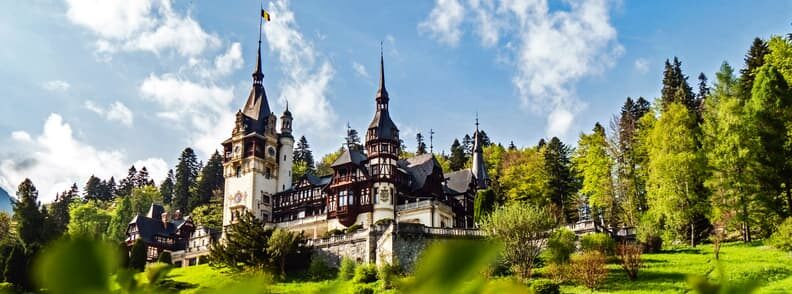Transylvania is a historical region in central and northwestern Romania, my home country. It is known for its beautiful landscapes and its many castles and fortresses. Some of the most famous castles in Transylvania include Bran Castle, also known as Dracula’s Castle, Corvin Castle, Peleș, and Pelișor Castles. These Transylvania castles are now popular tourist attractions and are known for their architectural beauty and historical significance.
Many magnificent and old castles, each with its own distinct history and architectural style, can be found in Transylvania. Făgăraș Citadel, Alba Carolina Citadel, Sighișoara Citadel, and the Râșnov Citadel are a few of the other well-known Transylvania castles. These castles were constructed at various points in history and had a variety of functions, including defense, governance, and habitation.
If you’re interested in learning more about the area, these beautiful castles in the heart of Romania provide a fascinating look into the history and culture of Transylvania and are well worth a visit.
Where is Transylvania?
The historical region of Transylvania is located in central and western Romania. It’s bordered to the east by the Carpathians, to the south by the Transylvanian Alps, to the west by the Mureş River, and to the north by the Apuseni Mountains. This area is renowned for both its natural beauty and its extensive historical past, which has several significant cultural and historical sites including Bran Castle and Hunedoara Castle.
How to get to Transylvania
There are several ways to get to Transylvania, depending on your starting location and preferred mode of transportation. If you are traveling by air, right now the nearest major airport is Henri Coandă International Airport in Bucharest, which is the capital of Romania. From the airport, you can rent a car or take a bus or train to reach Transylvania. Closer but smaller airports with international flights to Transylvania are Cluj Napoca, Sibiu, and – starting June 2023 – Brașov.
Alternatively, if you are traveling by car from another part of Romania, you can take the A3 motorway, which passes through the region.
Once you are in Transylvania, you can use local buses or trains to explore the region.
What to expect from Transylvania castles
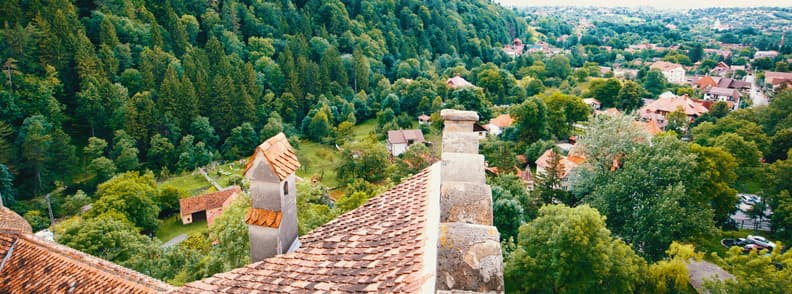
Transylvania castles are a unique and unforgettable experience. These historic buildings provide an intriguing window into the history and culture of the area and provide tourists with a diverse range of experiences. The public can take tours in Transylvania of several of the rebuilt castles, including Bran Castle.
The majority of these excursions involve a guided stroll through the castle grounds and a trip inside the building, where you can view historical objects and discover the castle’s past. Other castles, like Poenari Castle, can only be explored on foot because they are in ruins. The latter frequently have a more untamed, atmospheric feel, and they provide tourists with a more daring experience.
Check out my top 10 Transylvania castles list:
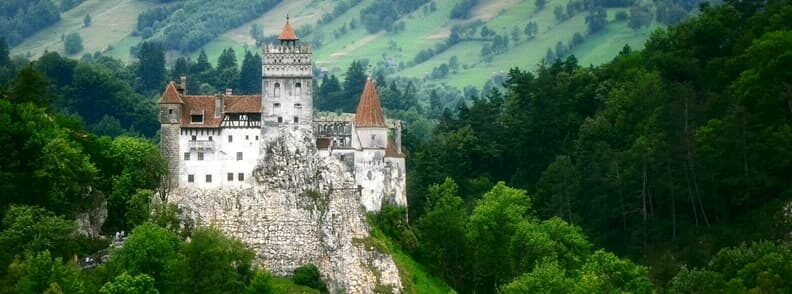
Bran Castle
Are you prepared for a journey across time? Then travel to Transylvania, Romania, and see Bran Castle – also known as Dracula’s Castle. Any traveler interested in history and folklore must visit this 13th-century castle in the Carpathian Mountains.
As you get closer, you’ll be astounded by the castle’s massive size and stunning setting on a clifftop overlooking the Bran Gorge. With a history spanning more than 700 years, it has made a significant contribution to Transylvania’s history.
As soon as you step inside the castle, the meandering passageways and rooms packed with historical antiques and exhibits will take you back in time. Over the years, this medieval fortress at the border between Transylvania and Wallachia has been used for various purposes, including as a fortress, a residence for the royal family, and a museum.
Learning about Bran Castle’s connection to the Dracula tale is one of the attractions of a visit to this Transylvania castle. Although there is no evidence that the castle was ever inhabited by the real-life Dracula, Vlad the Impaler, the castle’s location, and appearance are said to have inspired Bram Stoker’s novel, Dracula. Today, Bran Castle is a popular tourist attraction and is visited by thousands of people every year who are interested in its history and its association with the legend of Dracula.
You will discover the history of the area and the part Bran Castle played in it as you visit the castle. Along with furnishings and artwork from the castle’s earlier eras, exhibitions of weaponry and armor are also present. The castle’s defensive elements, such as its arrow slits and hidden corridors, as well as its architecture, will also be covered.
In addition to its rich history, Bran Castle is also known for its beautiful architectural features. The castle is built in the Gothic style and has four towers, each with a different design. The castle’s interior is equally impressive, with beautifully decorated rooms and furnishings. Overall, Bran Castle is a fascinating and unique attraction that offers visitors a glimpse into the history and culture of Transylvania.
A trip to Bran Castle is an extraordinary and unforgettable adventure. You won’t want to miss seeing this famous Transylvania castle, whether you love history, or folklore, or are just set on a thrilling day trip.
Why is Bran Castle famous?
Vlad the Impaler, the prince who once ruled over the province of Transylvania, is strongly linked to the Dracula legend. Vlad the Impaler was well-known for using horrific military strategies, like impaling his enemies on long wooden stakes. Because of his notoriety, Vlad the Impaler was given the moniker Dracul, which is Romanian for the devil. His coat of arms featuring a dragon (or draco in Latin) further added to this nickname.
Bram Stoker’s 1897 book, in which the main character is based on Vlad the Impaler, popularized the legend of Dracula. Bran Castle, a Transylvanian fortification from the Middle Ages, is frequently linked to the Dracula legend because the author is thought to have drawn inspiration from it for his book. However, there is no proof that Vlad the Impaler ever lived or visited this castle. Despite this, Bran Castle is a popular tourist destination in Romania and is famous for its connection to the Dracula legend.
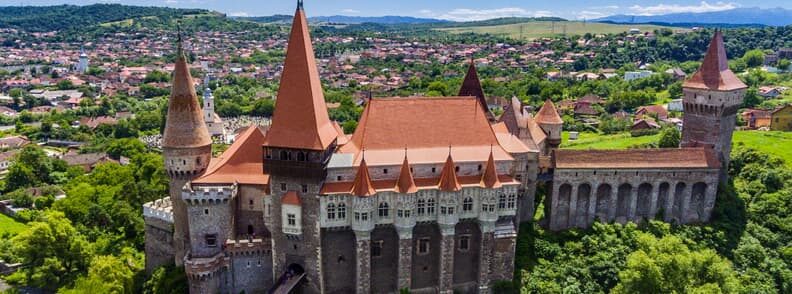
Corvin Castle
Corvin Castle, also known as Hunyadi Castle and often misspelled as Hunadaro Castle, is a medieval fortress located in the town of Hunedoara, in the region of Transylvania. This Transylvania castle was built in the 14th century by the Hungarian military leader John Hunyadi. Over the years, it has undergone several upgrades and additions, and as a result, it now serves as a symbol of the area’s extensive cultural legacy.
Hunedoara Castle is considered by many to be one of Europe’s most stunning and majestic castles. It is famous for its distinctive architectural design that combines Gothic, Renaissance, and Baroque architectural features.
Corvin Castle is encircled by a moat and tall walls, and it is rectangular in shape. It features a number of towers, each with a distinctive design, and battlements topped with crenellations. It consists of several structures, including a church and a dungeon. The interior of the castle, with its great halls, beautifully decorated chambers, and stunning views of the surrounding countryside, is equally impressive.
The Great Hall, the Knight’s Hall, and the Throne Room are just a few of the numerous halls and chambers that guests can tour. Hunedoara Castle also has a museum where a variety of historical items and papers are on show.
The arched ceilings of the castle are one of its most outstanding characteristics. The chapel of the castle is especially remarkable due to its Gothic design and exquisite murals.
For any traveler interested in history and architecture, or just seeking a special and unforgettable experience, a trip to Corvin Castle is a must. The beautiful Hunedoara Castle is a genuine Transylvanian jewel and a symbol of the area’s rich cultural history.
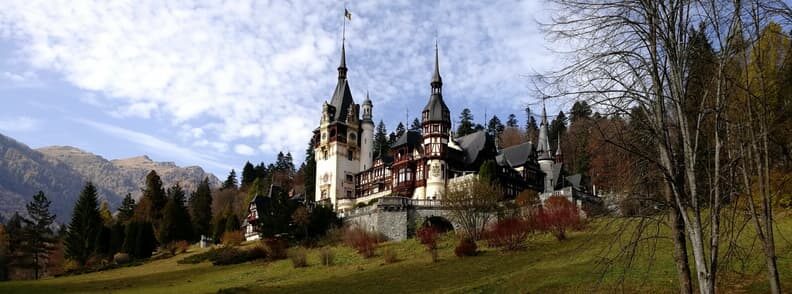
Peleș Castle
The Romanian Carpathian Mountains are home to Peleș Castle, a castle of outstanding beauty. Wilhelm von Doderer, a German architect, was hired by Romania’s King Carol I to create this Neo-Rennaisance castle. It was finished in 1914 after more than 20 years of construction. Today, it stands as a symbol of the affluence and authority of the Romanian royal family.
As you get closer, you’ll be astounded by this Transylvania castle’s imposing size and architecture. Its facade is decorated with beautiful carvings and sculptures. The four towers of the castle stand tall and proud, contributing to its royal image, and the roofs are decorated with red tiles.
You’ll be taken to a different time and place as soon as you step inside the castle. With opulent furniture, exquisite tapestries, and brilliant chandeliers, the inside is every bit as luxurious and elaborate as the outside. A magnificent hall with a lofty ceiling and a winding staircase ascending to the higher stories serves as the Peleș Castle’s main entrance.
You’ll find yourself in awe of the lavishly furnished apartments and the magnificent wall paintings as you tour the castle. Only the best materials and decorations were used to decorate every square inch of the castle, from the sumptuous dining room to the elaborate chambers.
Peleș castle, however, is more than simply a museum exhibit – it also serves as a record of the royal family of Romania’s lives and times. You will discover more about the royal family’s past and how they influenced Romanian history as you explore the castle. A few of the castle’s original furniture, including the royal family’s own collection of artwork and antiques, will also be on display for you to admire.
The castle served as King Carol I’s first royal home and remained a royal residence until 1947. Since then, it became a museum open to the public for tours. Today, the magnificent Peleș Castle attracts thousands of visitors every year with its history and architecture. You will love Peleș Castle if you’re a history buff, an art lover, or someone who simply appreciates beauty and grandeur.
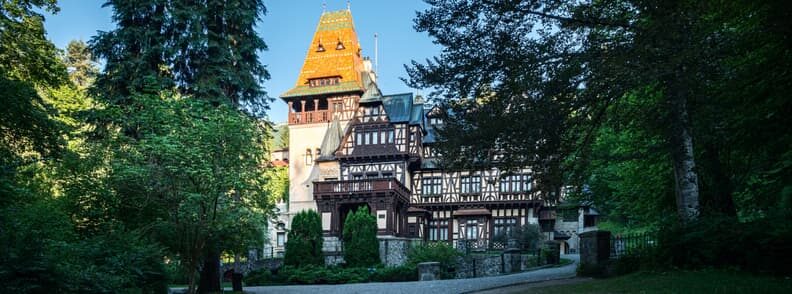
Pelișor Castle
A little castle called Pelişor Castle is located next to the bigger and more well-known Peleș Castle, in the same park and museum complex. Designed by Gerald Lampert, its architecture is a blend of Art Nouveau and Neo-Baroque styles, with a beautiful mix of curves and angles that give it a sense of movement and energy.
You’ll be amazed by Pelișor Castle’s opulent interiors as soon as you enter this small Transylvania castle. The magnificent entry hall of the castle has marble walls and flooring as well as a grand staircase leading to the top level. Both its many bedrooms and private rooms and its grand reception spaces are furnished with elaborate furnishings and ornamental accents.
Strolling through the castle’s lovely grounds (that it shares with the Peleș Castle above) is one of the main attractions of a visit to Pelișor Castle. With their meandering paths, fountains and statues, and an assortment of flowers and plants, these gardens are a veritable haven of calm and quiet. Additionally, there are lots of outdoor seating spaces where you can unwind and take in the beauty of the surroundings.
Pelișor Castle is home to a multitude of historical and cultural artifacts in addition to its beauty and majesty. A variety of items and objects are on display in this Transylvania castle’s museum to explain the tale of the Royal Family and the castle’s significance in Romanian history. It’s most famous for serving as the residence of Queen Mary of Romania, who is also responsible for many of the decorative choices inside.
Today, Pelișor Castle is open to the public for tours and is a popular attraction. Check the castle’s events calendar to see what’s happening during your visit because there are a number of exhibitions and activities hosted at Pelișor all year long.
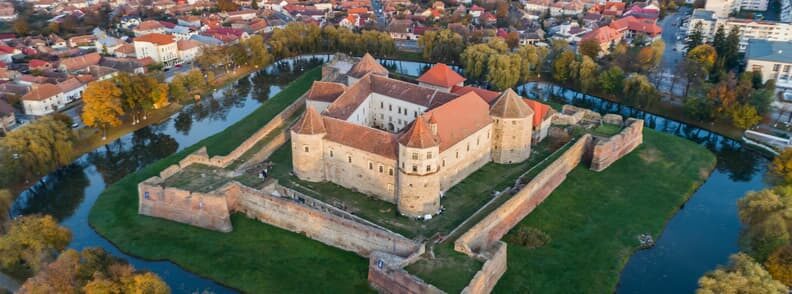
Făgăraș Fortress
Fagăraș Fortress is a medieval stronghold in the Romanian Transylvanian town of Fagaraş. This Transylvania castle was built in the 14th century by the Hungarian King Sigismund of Luxembourg. Originally used as a military fortress, it’s considered one of Europe’s best-preserved defenses. It’s popular with tourists for its distinctive and imposing architecture, which combines Gothic and Renaissance elements.
The Făgăraș Citadel’s stunning size and magnificence will wow you as you get closer. The turreted towers and imposing castle walls appear to reach the heavens. When you enter the castle’s gates, a world from the times of knights and dragons will appear before you.
A labyrinth of twisting passages and rooms containing historical objects and exhibits are inside this Transylvanian fortress. Visit the church to see lovely paintings and stained glass windows, or tour the Great Hall where the castle’s lords once held court.
The breathtaking vistas that the Făgăraş Citadel offers are the true draw, though. From the top of the castle walls, you can see for miles in every direction. Transylvania’s undulating hills sprinkled with forests, charming towns, and picturesque farmhouses will spread out before you.
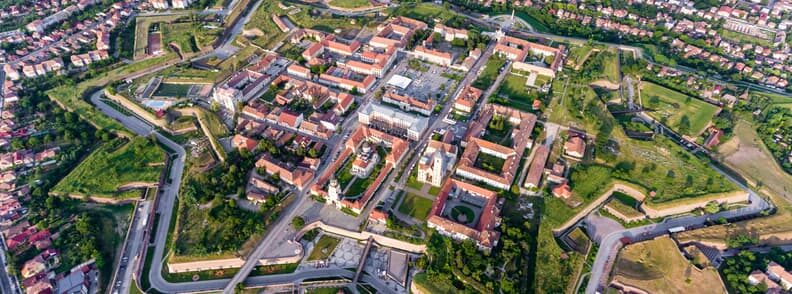
Alba Carolina Citadel
The massive star-shaped Alba Carolina Citadel is located in Alba Iulia, a city in the Romanian province of Transylvania. This 18th-century fortress is regarded as one of the best-preserved fortifications in all of Europe. Built by the Habsburg Empress Maria Theresa, Alba Iulia’s Fortress attracts visitors with its distinctive and imposing architecture that combines elements from the Neoclassical, Baroque, and Rococo periods.
You’ll be amazed by the castle’s towering size and magnificence as you get closer. Encircled by a moat, the stronghold’s walls rise out from the ground like a formidable fortress, standing tall against the elements.
The Alba Carolina Citadel’s museums provide a fascinating view of Transylvania’s history and culture. There is plenty for everyone to enjoy, from the Military History Museum, which delves into the turbulent past of the area, to the Art Museum, which exhibits the works of regional artists.
However, Alba Iulia’s fortress offers visitors the chance to live history and not just learn about it. You can join guided walks inside the citadel’s underground tunnels, once used to protect the castle against enemy invasions, and enjoy stunning views of the surrounding countryside from the ramparts.
A visit to the Ethnographic Museum, which examines Transylvania’s traditional way of life, is a must for anybody interested in learning more about the Alba Carolina Citadel. It displays regionally distinctive crafts, attire, and household goods, providing a window into daily life in the past.
A trip to the Alba Carolina Citadel is an experience you won’t soon forget, whether you’re a history fan, a cultural enthusiast, or just seeking a different kind of day trip. So pack your bags and travel to Transylvania to visit one of Romania’s most well-known historical sites.
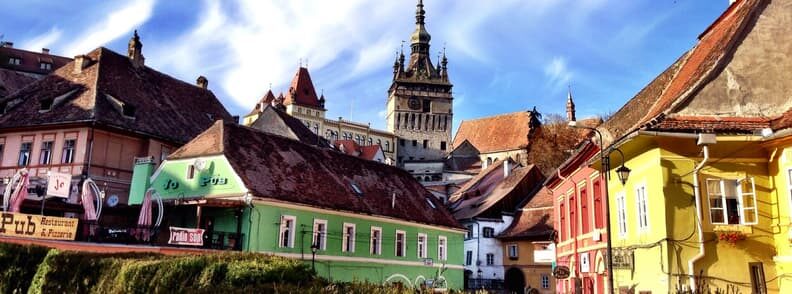
Sighișoara Citadel
Anyone traveling to Romania must visit the 12th-century Sighișoara Citadel, a well-preserved medieval town rich in history and culture, in the center of Transylvania. Bult by Transylvanian Saxons, Sighișoara has distinctive and imposing architecture, which combines Gothic and Renaissance styles.
You’ll be taken back in time as you walk on Sighisoara’s winding streets, learning about when the citadel’s fortified walls and towers were defending the town from invaders. Make sure you visit the 16th-century Clock Tower, a testament to the town’s history and resiliency.
The birthplace of Vlad the Impaler, commonly known as Dracula, is among the Sighișoara’s most intriguing features. The home where Vlad was born, which lies in the heart of the city, has been transformed into a museum that chronicles Vlad Țepeș’s life and the origins of the Dracula legend. You can visit the museum to discover more about the historical context that Bram Stoker used to create his well-known book.
The Sighișoara medieval town is not only significant historically, but it is also a center of culture. Numerous restaurants and cafés provide traditional Romanian dishes, while markets and artisanal stores are available for shopping for local handicrafts and souvenirs.
Sighișoara also hosts a variety of cultural occasions all through the year, such as music festivals, art exhibits, and theatrical productions. The most famous one is the annual Medieval Festival in Sighișoara, a must-see to relive history in this beautiful Transylvania castle.
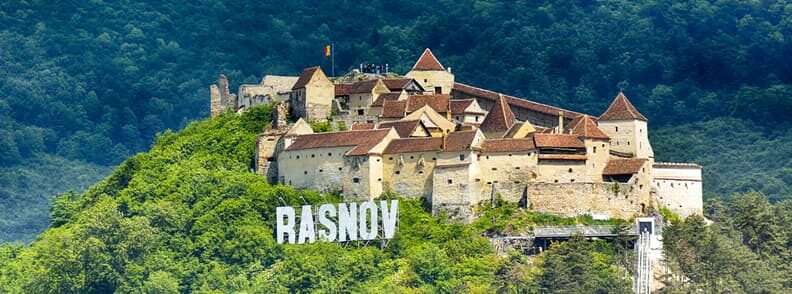
Râșnov Citadel
The medieval fortification known as Râşnov Citadel, commonly referred to as the Citadel of Râşnov, is situated in Râşnov, Romania. It is a well-liked tourist site and renowned for both its fascinating history and breathtaking views of the surroundings.
The fortress, which was built in the 13th century to fend against Mongol invasions, has been an important part of the area’s history. It has served as a jail, a military stronghold, and even a place of safety for the local populace during armed warfare.
The chance to see the fortress’s underground tunnels is one of the attractions of a trip to Râşnov Citadel. Both communication and escape were possible through these tunnels in times of invasion. The tunnels may be walked through by visitors who want to experience what it was like to live and work in the fortress.
Travelers can explore the towers, ramparts, and other defensive features of the citadel in addition to the underground passages. The stone walls of the citadel, which can be up to three meters thick in certain areas, make it a strong fortification.
Visitors can stop by the citadel’s restaurant after seeing it to relax and eat some typical Romanian cuisine. Additionally, there is a gift shop on the property where guests may buy keepsakes to commemorate their stay.
Anybody interested in history, architecture, or simply stunning vistas ought to pay a visit to Râşnov Citadel. Exploring the citadel is intriguing and provides a special window into the past.
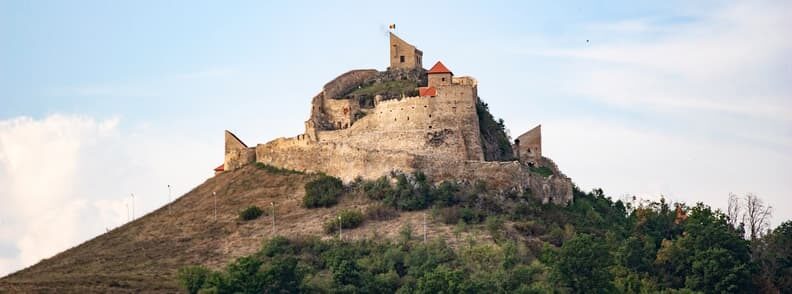
Rupea Citadel
A trip to Romania’s Rupea Citadel is unquestionably worthwhile if you’re searching for a distinctive and intriguing history lesson. This historic stronghold, which can be found in the county of Braşov, is perched atop a hill and provides breathtaking views of the surroundings.
The Saxons constructed Rupea Citadel in the 13th century as a line of defense against the Mongols, beginning the fortress’s existence. It has functioned as a fortress, a jail, and even a monastery over the years. It serves as a reminder of Romania’s lengthy and varied past today.
You’ll be amazed by the citadel’s towers and walls when you explore it. A huge gate guards the main entrance, and inside are a number of courtyards, dungeons, and chambers. The expert guides will be pleased to discuss the histories associated with each of these locations with you.
The chance to ascend the tower is one of the pleasures of a trip to Rupea Citadel. On a clear day, you can see for kilometers in all directions from where you are, and the sights are just amazing.
There is a small museum on the premises that displays a range of historical objects and records in addition to the main fortress. These contain antiquated atlases, firearms, and other fascinating relics that provide light on the history of the fortress.
In conclusion, everyone interested in history or just seeking a singular and unforgettable experience should pay a visit to Rupea Citadel. So be sure to include this amazing stronghold on your list of Transylvania castles to see if you’re planning a vacation to Romania.
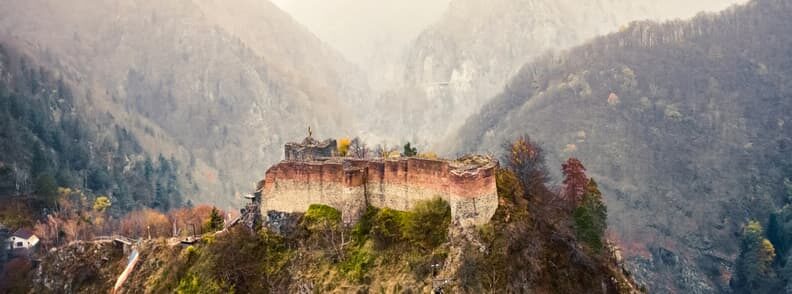
Poenari Castle
Any admirer of Dracula or Romanian history must visit Poenari Castle, the real Dracula Castle in Transylvania. Perched high on a rock overlooking the Argeș River in Transylvania, this castle has a turbulent history that dates back to the 13th century.
The Wallachian kings first constructed the castle as a stronghold to keep the area safe from attackers. After being abandoned and falling into ruin, it was eventually repaired and used as a summer residence by the infamous Vlad the Impaler, the ruler thought to have served as the model for the vampire Dracula.
Today, tourists can hike up to the castle and examine the partially rebuilt remains. The 1,480 stairs to the top of the cliff where Poenari castle once sat are not for the faint of heart, but the views from the top are worth it. Visitors may view the Argeș River, the surrounding landscape, and the ruins of the castle’s walls and towers from the summit.
Visitors can examine the ruins of the great hall, chapel, and other chambers inside the castle. A modest museum with displays on Vlad the Impaler and the history of the castle is also present there.
Poenari Castle is a fascinating and lovely location to visit for anybody interested in history or just searching for a different and exciting visit, despite its notoriety as Dracula’s Castle. This Transylvania castle is a must-visit attraction whether you’re a lover of the Dracula legend or simply want to see one of Romania’s most famous sites.
Transylvania Castles: a journey through Romania’s history
After exploring the breathtaking Transylvanian castles, it is evident that Romania is a nation rich in culture and history. These historic buildings, from the imposing Bran Castle to the mysterious Poenari Castle, are proof of the talent and cunning of its architects.
In addition to being intriguing to visit, these castles are surrounded by breathtaking natural beauty. Travelers are likely to enjoy Transylvania’s attractive landscape of undulating hills, thick woods, and flowing rivers.
Your journey to Transylvania will be a magical adventure, and I heartily recommend it to anybody searching for a unique and enriching travel destination. Visit Romania to experience for yourself its interesting history and stunning landscapes!

Mirela Letailleur is a Romanian travel blogger living in the South of France. She writes on The Travel Bunny travel blog about affordable travel in Europe. Creator of unique free travel guides and local travel expert. Problem solver. Wannabe coffee guru.
Other articles to discover Romania, my home country
100 Reasons to visit Romania: Discover the wonders of this beautiful country
Things to do in Timișoara in a weekend: The perfect itinerary
Most beautiful Black Sea beaches: the perfect destinations for sun, sand, and sea

